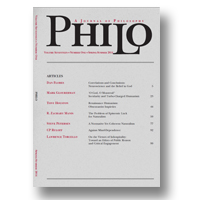|
articles |
|
1.
|
Philo:
Volume >
9 >
Issue: 1
Michael Thune
Naturalism, Hope, and Alethic Rationality
abstract |
view |
rights & permissions
| cited by
In my “Plantinga Untouched,” I argued that James Beilby’s recent objection to Plantinga’s EAAN was unsuccessful. Beilby has sincereplied that a naturalist can grant the Inscrutability Thesis and yet be alethically rational in hoping for a high P(R/N and future developments of E) and, therefore, needn’t accept the alethic defeater for R. I argue that this is impossible, since a naturalist cannot consistently grant that thesis and meet Beilby’s own criteria for alethic hope. Consequently, Plantinga is (still) right in maintaining that the naturalist who grants that P(R/N&E) is low or inscrutable has a defeater for R.
|
|
|
|
|
2.
|
Philo:
Volume >
9 >
Issue: 1
John Dilworth
Representation as Epistemic Identification
abstract |
view |
rights & permissions
| cited by
In a previous Philo article, it was shown how properties could be ontologically dispensed with via a representational analysis: to be an X is to comprehensively represent all the properties of an X. The current paper extends that representationalist (RT) theory by explaining representation itself in parallel epistemic rather than ontological terms. On this extended RT (ERT) theory, representations of X, as well as the real X, both may be identified as providing information about X, whether partial or comprehensive. But that information does not match ontological, property-based analyses of X, so it is epistemically fundamental—hence supporting a broadly conceptualist rather than nominalist metaphysics.
|
|
|
|
|
symposium on theories of simples |
|
3.
|
Philo:
Volume >
9 >
Issue: 1
Hud Hudson
Simple Statues
view |
rights & permissions
| cited by
|
|
|
|
|
4.
|
Philo:
Volume >
9 >
Issue: 1
Kris McDaniel
Gunky Objects in a Simple World
abstract |
view |
rights & permissions
| cited by
Suppose that a material object is gunky: all of its parts are located in space, and each of its parts has a proper part. Does it follow from this hypothesis that the space in which that object resides must itself be gunky? I argue that it does not. There is room for gunky objects in a space that decomposes without remainder into mereological simples.
|
|
|
|
|
5.
|
Philo:
Volume >
9 >
Issue: 1
Andrew Pyle
Atomism and Natural Necessity:
A Reconsideration
abstract |
view |
rights & permissions
| cited by
When the atomic theory was revived in the seventeenth century, the atomists faced a problem concerning the status of the laws of nature. On the face of it, the postulation of absolutely hard, rigid, and impenetrable atoms seems to entail the existence of natural necessities and impossibilities: Atoms A and B cannot interpenetrate, so atom A must push atom B when they collide. The properties of compound bodies are to be explained in terms of their “textures” (i.e., the arrangements of their constituent atoms) on the famous lock-and-key model. Once again, it looks as if we have a domain of natural necessities depending on the textures of compound bodies. But the atomists seem to think of the laws of nature as radically contingent, not the sorts of things that could in principle be known a priori. This article seeks to address this tension between what the atomists seem committed to by their matter theory (real necessary connections in nature) and what they in fact say (that all the laws are contingent). In my Atomism (1995) I sought to resolve the tension by appealing to a sharp distinction between the atomists’ metaphysics and their epistemology. On this interpretation, they remain committed to natural necessity, but insist that we can never do Natural Philosophy in the “high priori” manner, by discovering real essences and their necessary connections. Our sciences of nature must remain empirical. Since publication of Atomism, however, this possible solution of the problem has come to seem more doubtful. Reflection on the work of my three “dissenting voices” (Margaret Osler, Peter Anstey and Rae Langton) has forced a radical rethink, focussing on the problematic relation between the intrinsic properties of the atoms and their (dynamic) powers. If there is no discoverable intelligible connection between what the atom is in itself (its intrinsic properties) and what it does (its powers), then my earlier solution will turn out to be untenable.
|
|
|
|
|
6.
|
Philo:
Volume >
9 >
Issue: 1
Joshua T. Spencer
Two Mereological Arguments Against the Possibility of an Omniscient Being
abstract |
view |
rights & permissions
| cited by
In this paper I present two new arguments against the possibility of an omniscient being. My new arguments invoke considerations of cardinality and resemble several arguments originally presented by Patrick Grim. Like Grim, I give reasons to believe that there must be more objects in the universe than there are beliefs. However, my arguments will rely on certain mereological claims, namely that Classical Extensional Mereology is necessarily true of the part-whole relation. My first argument is an instance of a problem first noted by Gideon Rosen and requires an additional assumption about the mereological structure of certain beliefs. That assumption is that an omniscient being’s beliefs are mereological simples. However, this assumption is dropped when I present my second argument. Thus, I hope to show that if Classical Extensional Mereology is true of the part-whole relation, there cannot be an omniscient being.
|
|
|
|
|
review articles |
|
7.
|
Philo:
Volume >
9 >
Issue: 1
Graham Oppy
Logic and Theism:
Arguments for and Against Beliefs in God
view |
rights & permissions
| cited by
|
|
|
|
